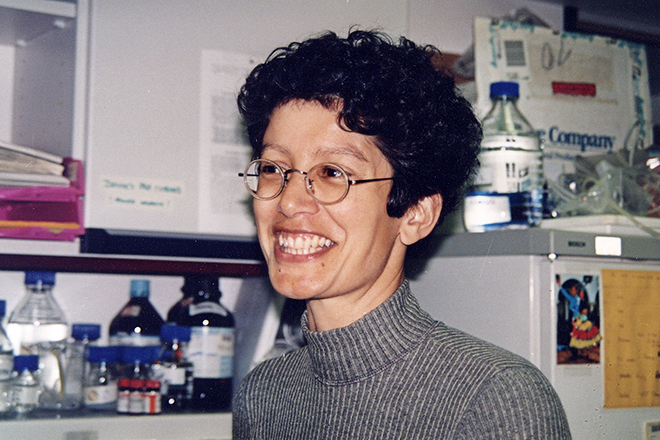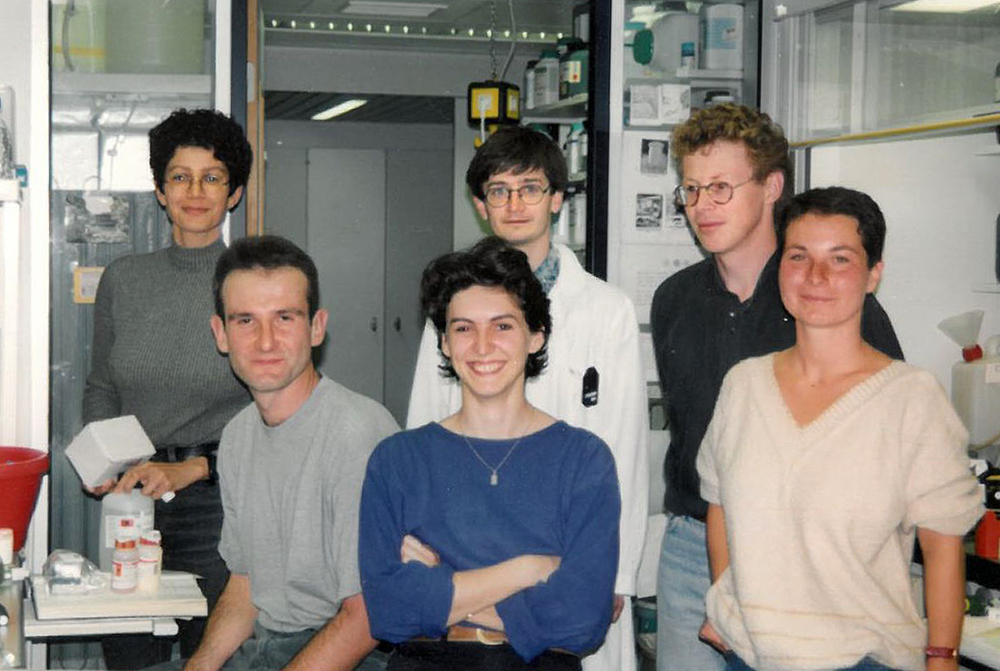Igf2r – a paradigm of genetic imprinting and epigenetic regulation
During her eight years as a group leader at the IMP, Denise Barlow made ground-breaking discoveries in the field of genomic imprinting – an epigenetic phenomenon underlying parent-of-origin-specific gene expression. She was a pioneer, not only as a founding figure in epigenetics, but also as the first female group leader at the IMP and a vocal supporter of diversity. When Denise passed away in 2017, obituaries in “Der Spiegel”, “Der Standard” and several scientific journals bore testament to her impact in the molecular life sciences.

Seminal contributions to the emerging field of epigenetics in the 1990s quickly established the IMP as an international heavyweight in the field. Denise Barlow, who joined the newly founded institute as a group leader in 1988, was instrumental in creating this reputation. However, her route to becoming a scientist, let alone a leading figure in a highly competitive field, was far from typical. Her school in the United Kingdom did not prepare its pupils for University, and instead she trained and worked as a nurse. But her inquisitive mind meant that she always wanted to know more – her training evoked questions on physiology in health and disease that her tutors were unable to answer. Therefore, Denise left her job, took the qualifying exams to go to University and began studying biology. From there, her career trajectory became more like that of a ‘typical’ scientist – after her degree she did a PhD at Warwick University, followed by postdoctoral work with Brigid Hogan at the Imperial Cancer Research Fund Mill Hill Laboratories in London (1981-1985) and with Hans Lehrach at the EMBL in Heidelberg (1985-1988).
During her postdoctoral work, Denise became particularly interested in new techniques to isolate genes. Compared to the ease of gene identification and isolation that scientists enjoy nowadays, molecular genetics was still rudimentary then – the mouse genome had not been sequenced and many molecular biology techniques considered standard today had not yet been developed. But Hans Lehrach, in particular, was developing many new techniques, and when Denise joined the IMP, she was better equipped than most to identify and clone genes important in development and disease.

By this stage, Denise had developed an interest in genomic imprinting – an unusual epigenetic mechanism whereby a gene is expressed from only one copy of the genome; either that inherited from the mother or from the father (most genes are expressed from both). She focused on a “maternal-effect” mutation in the mouse, called Tme, which mapped to chromosome 17. Mice that inherited a deletion of the Tme locus from their mother died before birth, whereas those inheriting the deletion from their father survived. This observation indicated that one or more genes in the deleted region were imprinted, but it wasn’t clear how to go about looking for them.
Using the techniques that she had learned in Heidelberg – including pulsed field gel electrophoresis, which allows the separation of very large chromosomal fragments – Denise and her co-workers narrowed down the region of interest, eventually assigning four genes to the Tme locus. They found that one of these, the insulin-like growth factor 2 receptor (Igf2r), was expressed only from the maternal allele – they had identified the first imprinted gene (Barlow et al., Nature 1991). The finding suddenly opened the door to studies on the mechanism of genomic imprinting, and, much more widely, on the epigenetic control of transcription.
Accordingly, Denise’s first PhD student Reinhard Stöger (now a group leader at the University of Nottingham), who had also helped identify Igf2r, set about looking for differences between the maternal and paternal copies. Why was one copy expressed and the other not? Since there was no difference in sequence, they suspected that an epigenetic modification was involved. At that time, DNA methylation was the only known epigenetic modification in mammals. It was known – in part thanks to the work of Adrian Bird, whose lab was on the floor below – that DNA methylation at promoters (at the beginning of genes) silenced gene expression. However, to everyone’s surprise, Reinhard found DNA methylation correlating with the imprinted signal on the active (maternal) and not on the silent (paternal) allele. What’s more, it wasn’t at the promoter, but in an intron in the middle of the gene.
Denise submitted the results to Cell. Unfortunately, the paper was rejected by the editor. They revised the manuscript and sent it again; it was rejected again. Reinhard still remembers the editor’s wording in that second rejection letter: “I shall not entertain a further version of this manuscript”. “I thought that was it”, he recalls. But not one to give up, Denise called the editor and evidently managed to convince him, as the paper was subsequently published (Stöger et al., Cell 1993). As had been clear to Denise, it was a seminal paper – the first to show differential methylation at an imprinted gene – and one that has been cited over 600 times since. The incident is just one example of Denise’s perseverance, which was based solidly on her scientific rigour and uncompromising attitude. In a rather unforgiving, male-dominated environment, she was often challenged to justify and defend her ideas, and she did so with determination and pugnacity.
Given the known repressive effects of DNA methylation, Denise suspected that methylation of the maternal allele could be ‘repressing a repressor’ that would otherwise silence Igf2r. But the researchers had no idea of the nature of this putative repressor, and it was rather by chance that they came across a strange RNA (which they named antisense Igf2r RNA non-coding, or Airn) transcribed from the differentially methylated intron observed by Reinhard. Anton Wutz, another PhD student, and now a professor at ETH Zurich, showed that Airn was expressed only from the unmethylated paternal allele (Wutz et al., Nature 1997). Work done in Denise’s lab after she left the IMP proved that Airn is indeed the repressor that is repressed by DNA methylation on the maternal Igf2r allele, and the discovery has had a long-term impact on the non-coding RNA field.
Igf2r became a textbook example of epigenetic regulation and is still being studied today. Although the function of genomic imprinting remains the subject of debate, Denise’s work at the IMP contributed to one popular theory, namely the “parental conflict hypothesis”. This theory proposes that imprinting reflects differing ‘interests’ of the mother and father – success of the offspring (even at the expense of the mother) is in the father’s interest, while it is in the mother’s interest to conserve resources for her own survival while leaving enough for current and subsequent offspring. Therefore, paternally expressed genes are often growth-promoting, while maternally expressed ones tend to be growth-limiting. In collaboration with Erwin Wagner’s group, also at the IMP, Denise generated mice lacking Igf2r. The phenotype was very similar to that described for the Tme mutation, and confirmed that Igf2r is required to repress growth in development (Wang et al., Nature 1994). Nonetheless, Denise reserved judgement on the evolutionary origins of imprinting, suspecting that much more remains to be discovered (Barlow, RNA Biol 2015).

After leaving the IMP in 1996, Denise led a group at the Netherlands Cancer Institute in Amsterdam, but returned to Austria in 2000, first as a Department Head in Salzburg at the Institute of Molecular Biology of the Austrian Academy of Sciences (which closed in 2003) and then as a principal investigator at the newly-established Center for Molecular Medicine (CeMM) in Vienna. Initially hosted at the Max Perutz Labs (where she was an honorary Professor of Genetics and a founding member of the Doctoral Program in RNA Biology), Denise moved to the new CeMM building in 2010, where she remained until her retirement in 2015. Giulio Superti-Furga, Scientific Director of CeMM since 2005, witnessed Denise’s career at different stages and over a long period of time, having also overlapped with her while doing his PhD with Meinrad Busslinger at the IMP (1988-1991). “Denise was an incredibly interesting person”, Giulio says. “It was impossible to be bored when having a conversation with her – she was original, she was funny, she had an opinion on everything.” “She was very headstrong”, Giulio notes; “and naturally argumentative”. But these characteristics served her, and ultimately science, very well.
Nobody can disagree that Denise had a lasting and positive impact on the Austrian biomedical research community and the field of epigenetics globally. She was also a vocal advocate for more inclusiveness and greater gender equality in science. “She was one of the most truly dedicated and passionate researchers I have ever met”, Giulio says. Perhaps because of her non-linear career trajectory, research was not just a profession to her – it was a lifestyle, a privilege, and one that she never took for granted, Giulio adds. “Because of that, she inspired a lot of people.”
First published in 2019.
References
The mouse insulin-like growth factor type-2 receptor is imprinted and closely linked to the Tme locus.
Barlow DP, Stöger R, Herrmann BG, Saito K, Schweifer N; Nature 1991
Maternal-specific methylation of the imprinted mouse Igf2r locus identifies the expressed locus as carrying the imprinting signal.
Stöger R, Kubicka P, Liu CG, Kafri T, Razin A, Cedar H, Barlow DP; Cell 1993
Regulation of embryonic growth and lysosomal targeting by the imprinted Igf2/Mpr gene.
Wang ZQ, Fung MR, Barlow DP, Wagner EF; Nature 1994
Imprinted expression of the Igf2r gene depends on an intronic CpG island.
Wutz A, Smrzka OW, Schweifer N, Schellander K, Wagner EF, Barlow DP; Nature 1997
Denise Barlow a career in epigenetics.
Barlow D; RNA Biology 2015